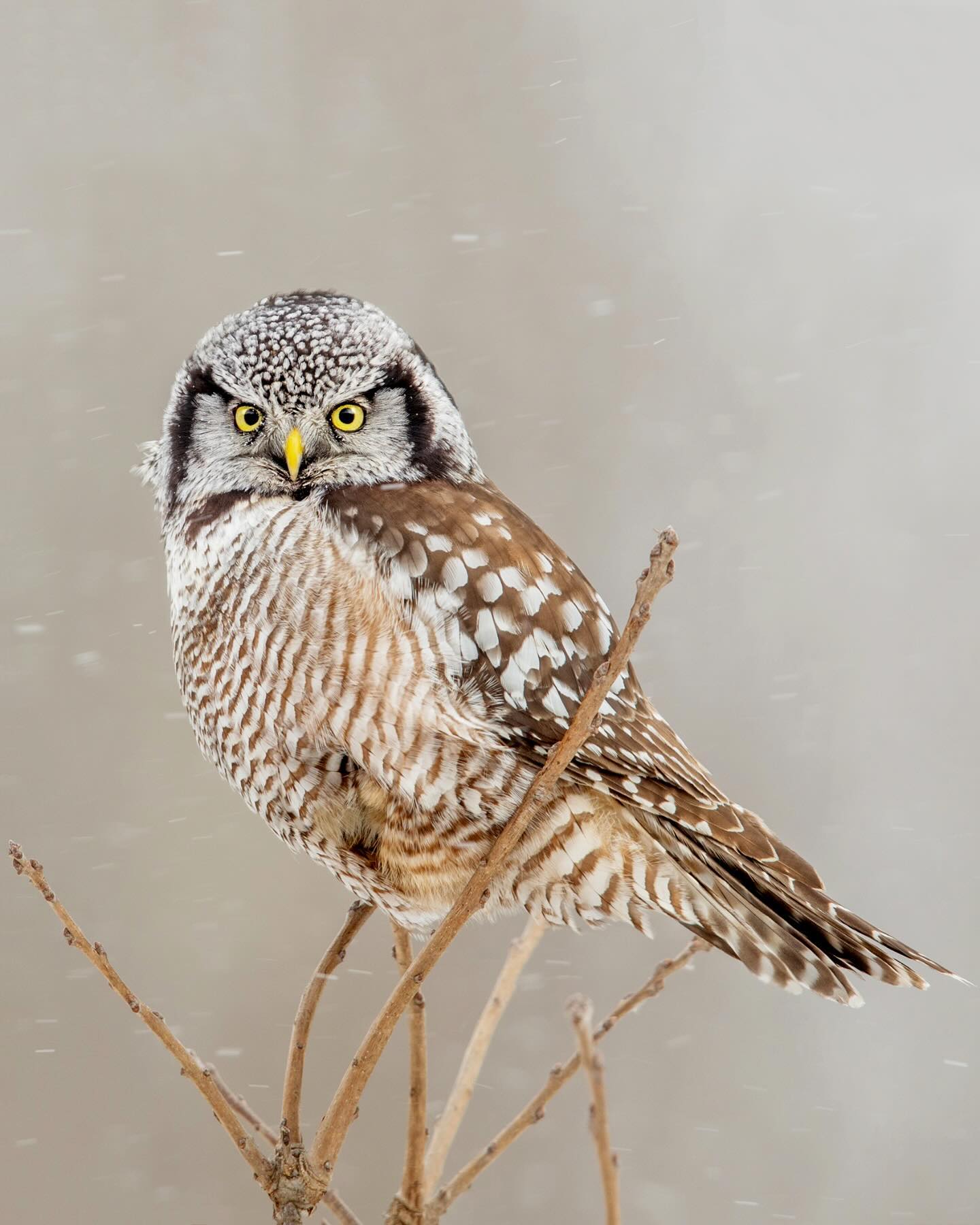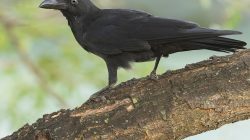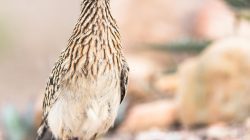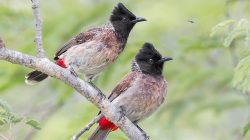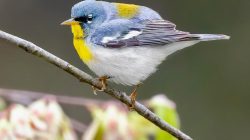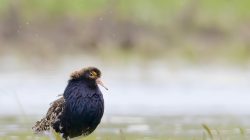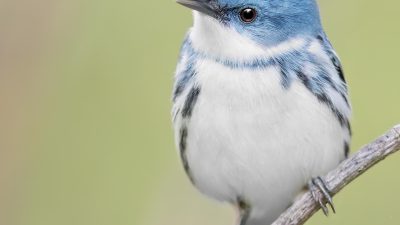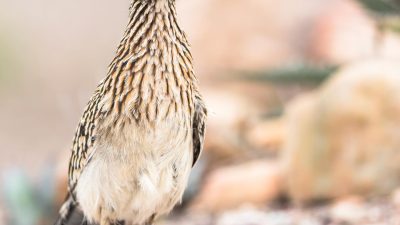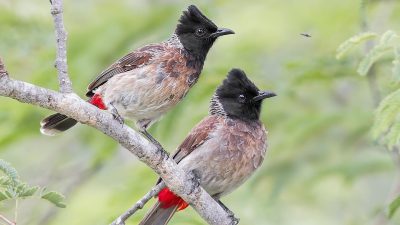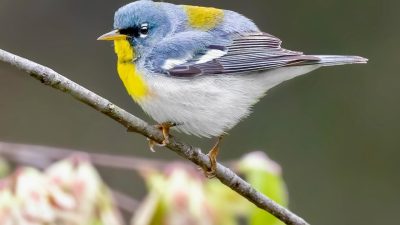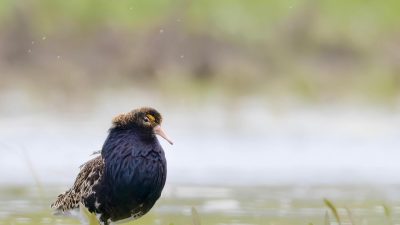Magnolia Warbler (𝘚𝘦𝘵𝘰𝘱𝘩𝘢𝘨𝘢 𝘮𝘢𝘨𝘯𝘰𝘭𝘪𝘢): A Comprehensive Study of an Iconic Migratory Bird
Diajar.net – The Magnolia Warbler, scientifically known as Setophaga magnolia, is a striking and diminutive songbird. The origin of its name is intriguing and rooted in both historical and ecological contexts. The genus name Setophaga is derived from Greek, where “setos” means “bristle” and “phagos” means “to eat,” referring to the bird’s distinctive feeding behavior, where it forages among the leaves and branches of trees. This genus is known for a group of colorful and energetic warblers that are primarily found in North America.
The specific epithet “magnolia” pays homage to the magnolia tree, a plant that is commonly found in the bird’s preferred habitats, such as the dense forests and woodlands of eastern North America. The bird was first described in 1810 by the naturalist Alexander Wilson, who encountered the species in the southeastern United States. Wilson was a notable figure in the study of American birds, and his naming of the species reinforced the connection between the Magnolia Warbler and the tree, a common sight in the bird’s native environment.
Appearance
The Magnolia Warbler is a small, brightly colored bird, measuring around 12 cm (4.7 inches) in length and weighing between 9 to 11 grams (0.3 to 0.4 ounces). Its most distinctive feature is its striking plumage. Males, during the breeding season, sport vibrant yellow underparts that contrast sharply with their dark grayish-blue back and wings. A black line extends through the eye, adding to the bird’s distinct facial pattern. The belly is yellow, with dark streaks on the sides, and the tail is slightly notched, further contributing to its unique silhouette.
Females and juveniles are generally less vibrant, exhibiting a more muted version of the male’s coloration, with grayish-brown upperparts and a paler yellow belly. This sexual dimorphism is common among many warbler species, with males typically being more brightly colored to attract mates during the breeding season.
The Magnolia Warbler’s small size, combined with its colorful plumage, makes it easy to identify, especially when it is flitting through trees in search of food. Its lively, active behavior adds to the appeal, as it is often seen darting between branches and leaves, making it a favorite subject for birdwatchers.
Distribution
The Magnolia Warbler is a migratory species primarily found in the eastern parts of North America. Its breeding range extends from southern Canada, particularly in the boreal forests of Alberta, Manitoba, and Ontario, down through the northeastern United States, including areas in New York, Michigan, and New England. During the summer months, these birds nest in coniferous and mixed woodlands, often at higher elevations.
In the winter months, however, the Magnolia Warbler migrates to Central America and the Caribbean. It is commonly observed in southern Mexico, Guatemala, and Honduras, as well as some of the islands in the Caribbean, including Cuba and Jamaica. The bird’s migratory patterns are part of the larger movement of warblers in the New World, which follow seasonal routes to take advantage of more temperate climates during colder months.
This migration is not only critical to the survival of the species but also serves as a fascinating example of long-distance travel in the bird world. Each year, the Magnolia Warbler faces the challenges of navigating thousands of kilometers, relying on instinct, environmental cues, and seasonal patterns.
Geography
The Magnolia Warbler’s geographical range is shaped by its preference for specific ecosystems and habitats. In the breeding season, it is most commonly found in temperate regions, particularly in forested areas with a mix of conifers and broadleaf trees. These forests, characterized by dense canopy cover, provide the perfect environment for the Magnolia Warbler to build its nest and forage for food. The bird prefers higher elevations within its range, where the habitat is relatively undisturbed and abundant in the insects it feeds on.
In terms of wintering habitats, the Magnolia Warbler prefers tropical and subtropical forests. The bird is often found in the cloud forests of the highlands in Central America, where the climate is cooler than the lowland areas but still provides the necessary food resources. The availability of insects in these regions makes them ideal for the bird’s diet, and the tropical forests offer shelter from the harsh northern winters.
Geographically, the species spans a broad area across both North America and Central America, though it is primarily confined to the eastern regions of the continent. The geographical shifts from breeding grounds to wintering areas are part of the species’ remarkable adaptation to seasonal changes.
Habits and Lifestyle
The Magnolia Warbler is an active, energetic bird that engages in continuous foraging, hunting for insects, and performing acrobatic flights through the trees. These birds are known for their habit of foraging on tree branches and leaves, using their sharp beaks to pick off insects, spiders, and small arthropods. Their diet is primarily insectivorous, and they are particularly adept at catching small flying insects in mid-air, a skill that requires both speed and agility.
Magnolia Warblers are solitary creatures, typically seen alone or in small groups, especially during migration. However, during the breeding season, males are territorial and defend their nesting areas against other males. The species is known for its high-pitched songs, which are often heard in the mornings and evenings. The male’s song is a series of clear, whistled notes, often described as “sweet-sweet-sweet-sweeeet,” which helps to establish territory and attract females.
These birds are highly migratory, and their lifestyle is dictated by the need to travel vast distances between breeding and wintering grounds. During migration, the Magnolia Warbler uses a variety of habitats for rest and feeding stops, including forested areas and open landscapes with dense vegetation. Their migratory behavior is instinctual, and they navigate using the sun, stars, and magnetic fields.
Diet and Nutrition
As an insectivorous bird, the Magnolia Warbler’s diet consists mostly of insects, spiders, and other small invertebrates. During the summer months, when food is abundant, these birds feast on caterpillars, ants, beetles, and a variety of flying insects, including moths and flies. They forage primarily in the upper canopy of trees, searching for insects on leaves and branches.
In the winter, the Magnolia Warbler’s diet shifts slightly, but it remains primarily insectivorous. In tropical environments, where food sources are more diverse, the warbler feeds on a range of insects found in the vegetation of the forest. They are also known to consume some fruits and berries, especially if their preferred insect prey is less abundant. However, insects remain the primary component of their diet year-round.
The bird’s high metabolism necessitates a constant supply of food to maintain its energy levels, particularly during migration, when it needs to accumulate fat stores for long flights. The insect-rich diet is rich in protein, which supports the bird’s energetic foraging behavior and its flight muscles during migration.
Population
The population of the Magnolia Warbler has been relatively stable over the years, though like many migratory species, it is subject to fluctuations based on environmental factors. The bird’s population is estimated to be in the millions, with breeding populations primarily concentrated in the boreal forests of Canada and the northeastern United States. According to estimates from bird conservation organizations, there are between 2 and 3 million Magnolia Warblers in total, with the vast majority residing in the breeding areas.
Population trends for this species are not completely uniform across its range. Some studies suggest that certain localized populations, particularly in areas affected by deforestation or climate change, may be experiencing slight declines. However, overall, the species is not considered to be in immediate danger of population collapse.
Population size can also fluctuate due to factors such as weather patterns and food availability during migration. In years of severe weather, fewer birds may survive their long migration, leading to short-term declines in population. Nevertheless, the Magnolia Warbler’s population remains robust, largely due to its wide distribution and adaptability to different environments.
Number of Populations
While the Magnolia Warbler’s total population is in the millions, the species is divided into several distinct populations, each tied to different breeding and wintering areas. The primary breeding population is located in the boreal forests of Canada, with a secondary concentration in the northeastern United States, particularly in regions of New York, Michigan, and Vermont. These populations are relatively isolated from one another, with limited mixing between individuals from different regions.
During migration, the Magnolia Warbler moves in large flocks, with the birds from different breeding populations often coming together as they head south to their wintering grounds in Central America. These migratory groups are not as geographically structured as the breeding populations, and the birds tend to form mixed-species flocks with other warblers and songbirds during migration.
The number of populations of Magnolia Warblers can fluctuate based on ecological factors such as habitat availability, food resources, and environmental conditions. However, the species overall is not considered to be fragmented into small isolated populations, and its wide range across North America and Central America provides the species with some resilience against population crashes.
Conservation
The Magnolia Warbler is currently listed as a species of “Least Concern” by the International Union for Conservation of Nature (IUCN), meaning it is not facing any immediate risk of extinction. This is largely due to its large and stable population, as well as its wide distribution across North America. However, there are some conservation concerns, especially related to habitat loss and climate change.
In the breeding regions of Canada and the northeastern United States, the Magnolia Warbler relies on forested habitats, particularly in areas of higher elevation. Logging, land development, and deforestation pose threats to these critical habitats, potentially reducing the availability of suitable nesting sites. Climate change is another significant threat, as rising temperatures and altered rainfall patterns can disrupt migratory routes and breeding cycles.
Conservation efforts for the Magnolia Warbler have focused on preserving its habitat, particularly in the boreal forests and forested regions of the northeastern United States. Several national parks and protected areas in Canada, such as the Banff and Jasper National Parks, provide vital sanctuary for this species. Additionally, bird conservation organizations are working to monitor population trends and implement strategies to mitigate the impacts of climate change on migratory birds.
Though the Magnolia Warbler is not currently endangered, ongoing efforts to protect its habitat and ensure the preservation of its migratory routes will be essential for maintaining healthy populations in the future.
The Magnolia Warbler is a fascinating bird, with its vibrant plumage, remarkable migratory behavior, and ecological importance. By understanding its biology, habits, and conservation needs, we gain insight into the broader challenges facing migratory birds in an ever-changing world. The continued protection of this species will require coordinated conservation efforts, ensuring that future generations can continue to marvel at this beautiful songbird.
